Events Calendar
Current Weather
Fishing in Algonquin Park
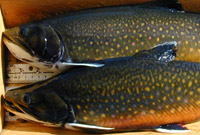
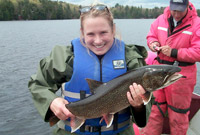
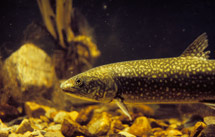
Algonquin Park has over 1,500 lakes and 1,200 kilometres of streams and we have recorded 54 different species of fish in the Park. In addition, Algonquin Park is home to some of the finest Brook Trout and Lake Trout fishing in the world!
Why is Algonquin Park Famous for Brook and Lake Trout?
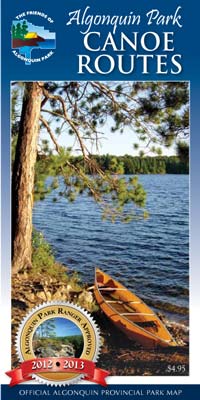 Lakes in the backcountry of the Park are not fished heavily because of their remote location. Lakes along Highway 60, where fishing pressure is higher, have special regulations to ensure the populations are not overfished. As a result, Algonquin Park is considered one of the finest locations for Brook Trout and Lake Trout in the world.
Lakes in the backcountry of the Park are not fished heavily because of their remote location. Lakes along Highway 60, where fishing pressure is higher, have special regulations to ensure the populations are not overfished. As a result, Algonquin Park is considered one of the finest locations for Brook Trout and Lake Trout in the world.
Spring provides some of the best fishing opportunities of the year. Many anglers say the best fishing is deep in the heart of Algonquin's backcountry, and the indispensable Canoe Routes of Algonquin Provincial Park map-brochure can lead you to that "secret lake."
Special Fishery, Special Regulations
Algonquin Park has outstanding fishing as a result of its numerous headwater lakes and rivers, remoteness, protection from development, and the Park's knowledgeable anglers. In order to ensure the protection of Algonquin's fragile fishery for the future, special fisheries and park regulations have been developed specifically for Algonquin Park. Highlights include:
- Possession (and use) of live baitfish is prohibited in Algonquin Park
- Dip nets and baitfish traps may not be used to harvest baitfish
- No regulated winter fishing (fish sanctuary from December 1 to late April)
- No fishing within 100 metres of any dam in Algonquin Park
- It is also illegal to transfer fish from one water body to another
- Motor restrictions
- Restrictions on caching boats and canoes
- For more information see the Fishing Regulations Summary & Park Rules and Regulations.
Call 1-877-847-7667 to report any illegal activity against Ontario’s natural resources.
Fishing Regulations Summary
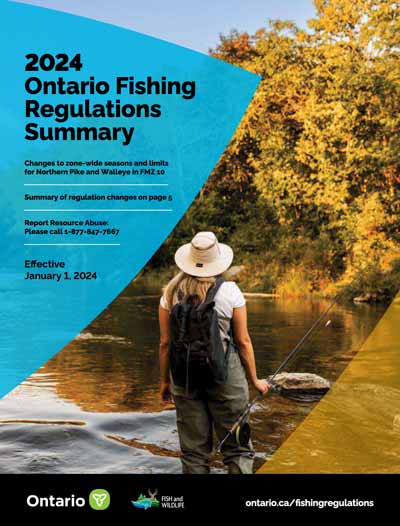
|
Every angler who fishes in the Province of Ontario must obey all applicable fisheries management regulations. Through research conducted right here in Algonquin Park, we have learned that Algonquin Park has unique aquatic environments. As a result, Algonquin has special fisheries regulations, such as a complete ban on live baitfish, to ensure the protection of this outstanding fishery. Download a PDF copy of the current Recreational Fishing Regulations Summary. |
Where to Purchase a Fishing License in Algonquin Park
Ontario fishing licenses are available for purchase at the following locations in Algonquin Park during normal business hours.
Fish Stocking in Algonquin Park
If you are looking for angling opportunities near the Highway 60 Corridor, you may want to try fishing for Splake which is a cross between Brook (Speckled) Trout and Lake Trout. These hard-fighting and tasty fish are stocked regularly in lakes along the Highway 60 Corridor.
Participate in Lake Trout Research on Lake Opeongo
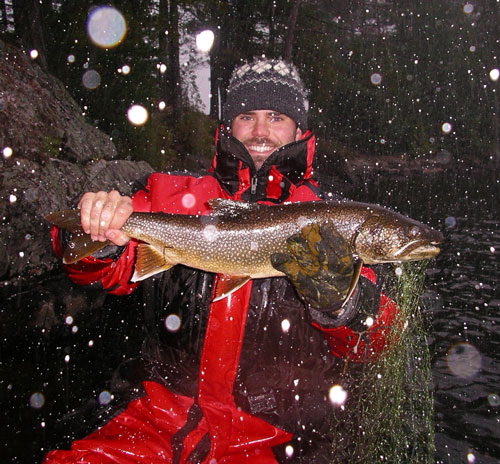 Head out onto the water with Harkness Laboratory of Fisheries Research staff in search of some of Algonquin Park’s largest Lake Trout during the peak of the fall spawning season. Through this exclusive Experience Algonquin Workshop offered by The Friends of Algonquin Park participate in ongoing Lake Trout mark-recapture and spawning survey on Lake Opeongo. Pre-registration for these paid workshops is required. Click below for more information.
Head out onto the water with Harkness Laboratory of Fisheries Research staff in search of some of Algonquin Park’s largest Lake Trout during the peak of the fall spawning season. Through this exclusive Experience Algonquin Workshop offered by The Friends of Algonquin Park participate in ongoing Lake Trout mark-recapture and spawning survey on Lake Opeongo. Pre-registration for these paid workshops is required. Click below for more information.
Fisheries Research Publications
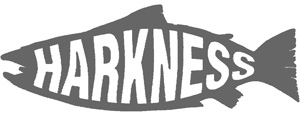 Below are scientific publications about Algonquin Park developed by the Harkness Laboratory of Fisheries Research. Harkness Laboratory is a field station focusing on excellence in aquatic research by government scientists, university faculty, and graduate students. Harkness is one of Canada's oldest field stations, established in 1936 on Lake Opeongo in Algonquin Park. Harkness Lab is operated by the Ontario Ministry of Natural Resources and Forestry.
Below are scientific publications about Algonquin Park developed by the Harkness Laboratory of Fisheries Research. Harkness Laboratory is a field station focusing on excellence in aquatic research by government scientists, university faculty, and graduate students. Harkness is one of Canada's oldest field stations, established in 1936 on Lake Opeongo in Algonquin Park. Harkness Lab is operated by the Ontario Ministry of Natural Resources and Forestry.
- A History of Fish Stocking in Algonquin Provincial Park (IR-07)
- Aquatic Ecology, History, and Diversity of Algonquin Provincial Park (IR-10)
- Aquatic Connectivity, Fish Introductions, and Risk Assessment for Lakes in Algonquin Provincial Park (IR-13)
- Climate Warming Projections for Algonquin Provincial Park (IR-14)
- From Aquatic Connectivity to Aquatic Conservation in Algonquin Provincial Park (IR-20)
- The Smoke, Canoe, and Tea Lake Fish Movement Project in Algonquin Park (IR-22)
- Assessing Recreational Angling in Algonquin Provincial Park (TR-35)
- A Cost-Effective Method to Estimate Total Angling Effort, Catch and Harvest within Ontario Provincial Parks (by the Algonquin Fisheries Assessment Unit)
Additional Information
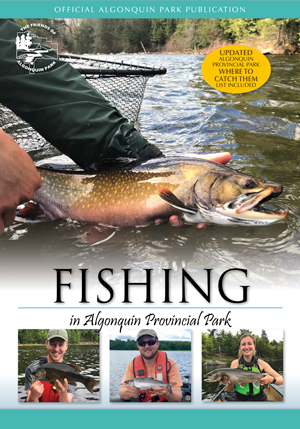 |
Fishing in Algonquin Provincial Park - Many visitors come to the Park with little or no idea of how or where to fish, or even the kinds of fish that might be expected. This book is intended to give you the information that may make the difference between success and failure. A detailed table in this book describes what fish you'll find in many of the Park lakes. |
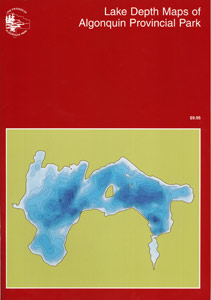 |
Lake Depth Maps of Algonquin Provincial Park - With the help of current technology, Park staff have surveyed 23 of Algonquin's most popular lakes to produce colour maps showing what is beneath the deep, cold waters of Algonquin's lakes. This book, an asset to anglers and canoeists, includes key lake characteristics such as fish species present, and historical significance. |
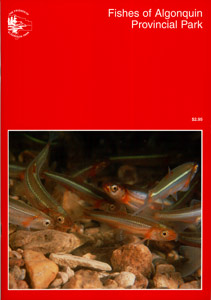 |
Fishes of Algonquin Provincial Park - Over 50 kinds of fishes occur in Algonquin but their appearance, behaviour, and ecology are largely unknown to most visitors. This book fills the gap with outstanding colour photos of living fish, Park distribution maps, and a definitive text by two of Canada's leading ichthyologists. |
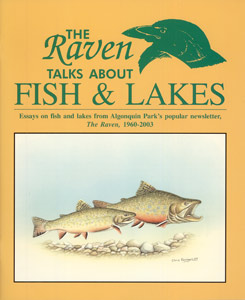 |
The Raven Talks about Fish and Lakes - A compilation of fisheries-related articles from "The Raven," (the Park's popular newsletter) from 1960 to 2003. This inexpensive publication showcases Algonquin's notable concentration of trout lakes compared to other areas of Ontario, plus their relative pristine state inside Park boundaries. This enjoyable read also details the impact by humans upon Algonquin's fisheries, and sadly, even bigger changes that seem inevitable. |
Fisheries Research in Algonquin Provincial Park
Not easily observed in their watery environment, except during the spawning season, Brook Trout are usually seen by visitors on the end of a hook, destined for a frying pan. Most people do not give much thought to how many fish might be in a lake, or the age of the fish they just caught. For fisheries biologists at the Harkness Laboratory of Fisheries Research, these are things they think about regularly.
Guide to Eating Ontario Sport Fish
The interactive Guide to Eating Ontario Sport Fish allows you to easily find consumption advice for sport fish in lakes and rivers across Ontario, including those in Algonquin Park.
Related Information
Reserve your developed or backcountry campsite for your next visit.
Share your passion for Algonquin Park by becoming a member or donor.
Special regulations for Algonquin's special fishery.









